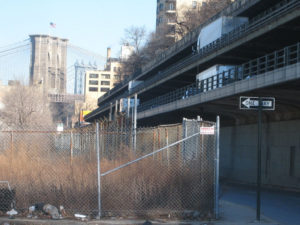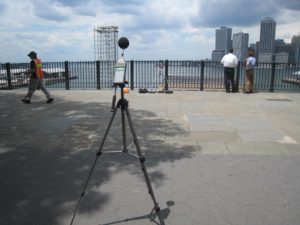A Waterfall in Brooklyn (part 2 of 2)
04.20.2009 | HMMH |by Doug Barrett
Famous for its rush-hour traffic, the Brooklyn Queens Expressway (BQE or I-278) runs from southern Brooklyn to the Grand Central Parkway in Queens, carrying a daily traffic volume of approximately 140,000 vehicles. The most notable bridge along the project corridor, the triple cantilever, is a reinforced concrete, multi-level structure built in 1948. It carries six lanes of the BQE on two cantilevers, with the three eastbound lanes located above the three westbound lanes. The third cantilever features the Brooklyn Heights Promenade, a pedestrian walkway with views of the East River and the Manhattan skyline. Now over 60 years old, this structure is in need of rehabilitation (excerpted from the ACTT BQE Project workshop).
In addition to being an ingenious way to squeeze a major highway through a narrow corridor adjacent to the historic Brooklyn Heights neighborhood, the triple cantilever is notable for being one of the most elegant and effective highway noise barriers in the U.S. Much like the parapet along the edge of the Empire State Plaza, the Promenade itself acts as a noise barrier by blocking the direct sound-propagation path from traffic below. As a result, pedestrians enjoying the Promenade may be completely unaware that a steady stream of cars and trucks is passing just below their feet. HMMH currently is providing noise consulting services for the project scoping phase of the triple cantilever’s rehabilitation. Last summer, we conducted a noise measurement program to document existing conditions and also assist in forecasting future noise levels. In addition to the usual noise sources that often complicate urban traffic noise measurements (aircraft overflights, helicopters, sirens, barking dogs, curious passersby, etc.), we encountered something new during BQE measurements.
By chance, our measurement program coincided with an entirely unrelated public art project featuring the temporary installation of artificial waterfalls at various locations around New York City. The closest waterfall to the project site was hundreds of yards away across an abandoned pier area, destined for future use as the new Brooklyn Bridge Park. One day we conducted a set of measurements to document the fall-off in noise levels as one moved away from the edge of the Promenade. Much to my delight, as I stepped back from the railing above the streaming traffic that afternoon, the roadway noise melted away and I was greeted by the sound of a cascading waterfall along the Brooklyn waterfront.








